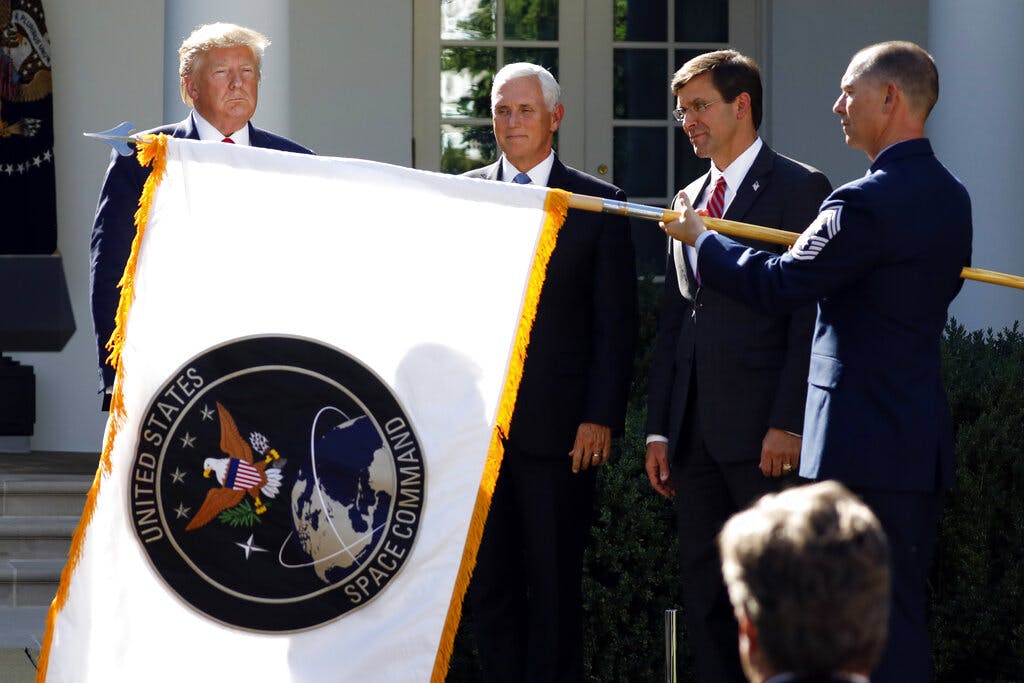America’s Space Force Gets Its First Deployment Abroad
The deployment says a lot about America’s perception of the threat posed not just by North Korea but more importantly by China, by far Washington’s main concern in the region.

Call them America’s spacemen and spacewomen or space cadets, but the first of them to be deployed overseas are now on the ground in South Korea eyeing what the North Koreans are doing with their missile program and figuring how to shoot them down if the North ever actually fires one.
U.S. Space Forces Korea, with their own distinctive uniforms, is now in action at Osan Air Base, headquarters of the U.S. Seventh Air Force, about 40 miles south of Seoul. Almost all its members are from the Air Force, but the unit is a component of the U.S. Space Forces Indo-Pacific Command in Honolulu.
Why South Korea was chosen as the first place overseas to deploy the space force says a lot about America’s perception of the threat posed not just by North Korea but more importantly by China, by far Washington’s main concern in the region.
The unit might appear initially to be just a token force, a minor augmentation to the 28,500 American troops in South Korea, but it clearly represents the way of the future as interest intensifies in space warfare, maybe even a real-life enactment of “Star Wars” in decades and centuries to come.
But what will the Space Force, a new branch of the armed forces, initiated in 2019, a legacy of the Donald Trump presidency, actually do that the airforce and army aren’t already doing? The commander of U.S. Forces Korea, General Paul LaCamera, spoke in carefully vague terms about the importance of the new unit at its inaugural ceremony.
The activation of the unit, he said, “enhances our ability to defend the homeland and should ensure peace and security on the Korean Peninsula and in Northeast Asia.” For sure, he strongly implied, the conservative South Korean government of President Yoon Suk-yeol was delighted with what appears as a move toward hardening of the confrontation with North Korea.
“Because of U.S. Space Forces Korea,” said General LaCamera, “the alliance is better able to exercise multi- domain operations in the Korean theater of operations.”
There was no doubt that China, not North Korea, was uppermost on the minds of the strategists who decided South Korea, not Japan or perhaps a NATO ally, was the right place for the first Space Force unit outside the United States.
“With China as a threat,” said the region’s top spaceman, Brigadier General Anthony Mastalir, commander of U.S. Space Forces Indo-Pacific, “activating this command underscores our continued commitment to a free Indo-Pacific.”
But how big a deal is the Space Force, really? The unit consists of a few hundred men and women, at most, and it’s commanded not by a general or colonel but by a lieutenant colonel, who came over from the air force.
The newly minted commander, Lieutenant Colonel Joshua McCullion, left no doubt about his belief in the mission in which he’s playing an historic role. Up north, above the demilitarized zone between the two Koreas, he warned of “an existential threat that we must be prepared to deter, defend and, if required defeat.”
For now, however, the role of U.S. Space Forces Korea will be more prosaic, possibly even boring at times. The unit’s first task will be to track North Korean missile shots, providing what the American command said would be “in-theater, near-real-time detection and warning of ballistic missile launches.”
Considering that the North has launched dozens of missiles this year, the space men and women should be pretty busy. But then, what will they find out that the American and South Korean commands weren’t already gleaning every time North Korea launches a missile?
The North Koreans, though, were sure to see the activation of the unit as compounding the threat posed by the Americans and South Koreans – all the more reason for North Korean leader Kim Jong-un to stand firm against demands to do away with his nuclear and missile program. He’s still expected to order the North’s seventh nuclear test – its first since 2017.

